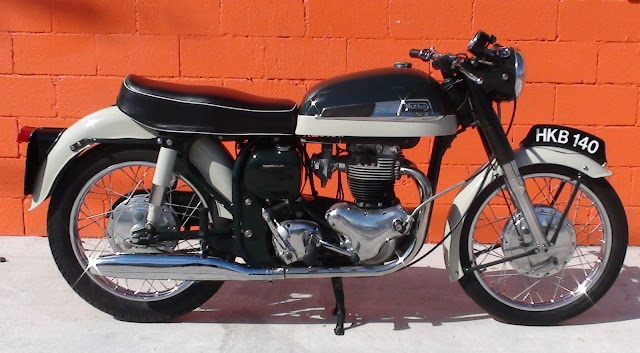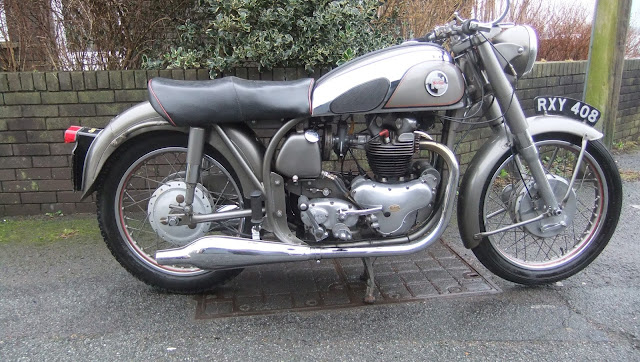Norton Dominator 88

This 960 model Dominator has the slimline Featherbed frame and narrower fuel tank that were introduced in that year, making the Norton more manageable.
The 1958 Dominator 88 combined the original wideline Featherbed with Norton’s 497cc parallel twin engine. The result was superb handling plus lively straight-line performance.
Norton took more than ten years to compete with Triumph by producing a parallel twin roadster of its own. But eventually in 1949 the firm unleashed a rival to the Speed Twin, in the form of the Model 7, known as the Dominator. The new bike centred on a 497cc ohv pushrod engine created by Norton's chief designer Bert Hopwood, who had previously worked with Speed Twin designer Edward Turner at both Ariel and Triumph.
Hopwood’s engine differed in numerous ways from Triumph’s twin, not least in having a single camshaft in front of the engine, instead of two separate cams at back and front. Although the Dominator was not particularly powerful, with a peak output of 29bhp, it was tractable, reliable and reasonably smooth. The motor was also compact because for cost-saving reasons it was designed to fit in the frame from Norton’s top-of-the-range single, the ES2.
Featherbed frame
That was no handicap, because the Model 7’s light weight and sound chassis combined to give good handling - at least until the plunger rear suspension system became worn, after which the bike would weave at speed. Norton’s response came with the bike’s replacement, the Dominator 88, which was launched on the export market in 1952 and in Britain in ’53. This featured the 497cc engine in a roadgoing version of Norton’s twin-shock Featherbed frame.
The Featherbed had become famous through its use on the single-cylinder racing Manx. But the McCandless brothers, its creators, had always intended it to be capable of housing various types of Norton engine and gearbox, and the distinctive twin-loop design proved ideally suited to the twin- cylinder powerplant. ‘That this frame is race bred is universally known,’ enthused Motor Cycling in a test of the Dominator. ‘It deserves to be as widely known that the steering is a delight and the handling a bend-swinger’s dream.'
Norton uprated the engine several times during the decade. In 1955 the 88 unit gained an alloy cylinder head, higher compression and Amal Monobloc carburettor. A year later came the Dominator 99, with its engine bored and stroked to increase capacity to 597cc. and output to 31 bhp. The Dominator 99’s race-developed Daytona camshaft, also adopted by the 88, helped lift the larger model’s top speed to just over lOOmph (161km/h).
In 1960 Norton made a further improvement by fitting both models with the firm’s new slimline Featherbed frame - a narrower version of the original - along with a new rear sub-frame and narrower fuel tank. Some riders have argued that the wideline frame is more rigid and gives better handling under racing conditions. But for roadgoing use there was no difference, and the 'limline Dominator was notably more manageable for the short of leg.
Either way, one of the Dominator’s great 'trengths was that its chassis remained very much n control of its powerplant. Norton’s engine was never the most powerful of contemporary twins. Although the Dominator 88 had reasonably brisk .icceleration and a respectable top speed of about J5mph (153km/h), riders in search of straight-line :r.rills were better rewarded by rival twins from Triumph or BSA.
But if the 88’s engine was unexceptional, its - “.assis made up for that. On a long, straight road there were several bikes that would show the Norton Dominator a clean pair of silencers. But when there were plenty of bends on the route, the Dominator’s flexible power delivery, superb handling and unbeatable roadholding made the Norton both very fast and wonderfully enjoyable to ride.
The Dominator 88 engine of 1958 benefited from improvements, notably alloy cylinder head, higher compression ratio and Amal Monobloc carburettor.
Specification Norton Dominator 88 (1958)
- Engine Air-cooled ohv pushrod four-valve parallel twin
- Capacity 497cc (66 x 73mm)
- Maximum power 30bhp @ 7000rpm
- Transmission Four-speed, chain final drive
- Frame Steel twin cradle Featherbed
- Suspension Roadholder telescopic front; twin shocks rear
- Brakes Drum front and rear
- Weight 405lb (184kg)
- Top speed 95mph (153km/h)


















0 comments: